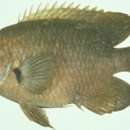fr
noms dans le fil d’Ariane


The lagoon damselfish (Hemiglyphidodon plagiometopon), also known as the sweetlip damsel, is a species of ray-finned fish, a damselfish from the family Pomacentridae. It is a larger species of damselfish which is found in the Indo-Pacific where it occurs around branching corals in sheltered areas of reefs.
The lagoon damselfish is a large brown species of damselfish, often the adults have a pale russet head and the colour of the fish gradually darkens towards the tail. There are pinkish markings on the operculum. The juveniles are dark blue to brownish on the head and near body and are yellow towards the tail and on the underside with a large iridescent blue eyespot on the dorsal fin, and blue bands and spots near the head on its body.[4] They grow to a maximum length of 18 centimetres (7.1 in).[5] Sometimes the only distinctive marking is a yellow eyering.[6]
The lagoon damselfish is found in the eastern Indian Ocean from Thailand through Indonesia, the Philippines and the Timor Sea into the western Pacific where it is found south to Australia and north to China and east to the Solomon Islands.[5]
The lagoon damselfish is found in sheltered reefs and lagoons, often in areas of high turbidity and a silty substrate at the base of branching corals.[4] They are found at depths of 1–20 metres (3.3–65.6 ft).[7] They are detritovores and the species has up to three times the number of gill rakers than other damselfish which are for feeding on fine detritus. They are territorial and defend a patch of algal covered reef. While feeding on detritus they will consume small amounts of algae and invertebrates.[4] They form pairs for breeding,[5] clearing an area to create a nest, then they begin in a mating dance which involves fast swimming and movements of the fins. While mating, the males frequently darken and may develop white blotches. The eggs are laid at dawn,[7] the eggs are demersal and adhere to the substrate where the male guards and aerates them.[5]
The lagoon damselfish has not been evaluated for the IUCN Red List of Threatened Species but it may be threatened by habitat degradation and by human exploitation.[6]
 juvenile Japan
juvenile Japan The lagoon damselfish (Hemiglyphidodon plagiometopon), also known as the sweetlip damsel, is a species of ray-finned fish, a damselfish from the family Pomacentridae. It is a larger species of damselfish which is found in the Indo-Pacific where it occurs around branching corals in sheltered areas of reefs.
Hemiglyphidodon plagiometopon Hemiglyphidodon generoko animalia da. Arrainen barruko Pomacentridae familian sailkatzen da.
Hemiglyphidodon plagiometopon Hemiglyphidodon generoko animalia da. Arrainen barruko Pomacentridae familian sailkatzen da.
Hemiglyphidodon plagiometopon (Bleeker, 1852) è un pesce osseo appartenente alla famiglia Pomacentridae, unico membro del genere Hemiglyphidodon[1].
La specie è diffusa nelle zone tropicali dell'Oceano Indiano centrale e dell'Oceano Pacifico occidentale dal mar delle Andamane a ovest alle isole Salomone a est, raggiungendo a nord le Filippine e l'estremo sud della cina mentre a sud arriva alla grande barriera corallina australiana[2][3].
Vive nelle zone più riparate delle barriere coralline come le lagune degli atolli o fra i rami dei coralli, in aree ricche di vegetazione algale[2][3].
Si può trovare a profondità fra 1 e 20 metri[3].
La colorazione dell'adulto è bruna che sfuma diventando nerastra nella parte posteriore del corpo, nella parte spinosa della pinna dorsale, nella pinna anale e nella pinna caudale. C'è una macchia scura alla base delle pinne pettorali. La livrea giovanile è molto diversa, giallo arancio nella parte ventrale e posteriore del corpo e grigiastra più o meno scura sulla testa e la parte anteriore del dorso con linee e punti blu sulla parte grigia e, talvolta, una macchia nera bordata di blu sulla pinna dorsale[2].
Raggiunge i 18 cm di lunghezza[3].
È un animale diurno[3].
Si nutre di alghe bentoniche[4].
È una specie ovipara, le uova aderiscono al fondale e vengono sorvegliate dal maschio[3].
Hemiglyphidodon plagiometopon (Bleeker, 1852) è un pesce osseo appartenente alla famiglia Pomacentridae, unico membro del genere Hemiglyphidodon.
Hemiglyphidodon plagiometopon is een straalvinnige vissensoort uit de familie van rifbaarzen of koraaljuffertjes (Pomacentridae).[1] De wetenschappelijke naam van de soort is voor het eerst geldig gepubliceerd in 1852 door Bleeker.
Bronnen, noten en/of referentiesHemiglyphidodon plagiometopon - gatunek morskiej ryby z rodziny garbikowatych, jedyny przedstawiciel rodzaju Hemiglyphidodon Bleeker, 1877. Gatunek o niewielkim znaczeniu gospodarczym. Hodowany w akwariach morskich.
Wody przybrzeżne, osłonięte laguny i rafy koralowe zachodniej części Oceanu Spokojnego, na głębokościach od 1-20 m p.p.m.
Ciało krępe, ciemnobrązowe, u młodych osobników dołem żółto-pomarańczowe z niebieskimi plamami i liniami na głowie i grzbiecie. 13 twardych i 14-15 miękkich promieni w płetwie grzbietowej. Żywią się glonami. Dorastają do 18 cm długości.
Hemiglyphidodon plagiometopon - gatunek morskiej ryby z rodziny garbikowatych, jedyny przedstawiciel rodzaju Hemiglyphidodon Bleeker, 1877. Gatunek o niewielkim znaczeniu gospodarczym. Hodowany w akwariach morskich.
密鳃鱼(学名:Hemiglyphidodon plagiometopon),又名密鰓雀鯛,为雀鲷科密鳃鱼属的鱼类。分布于印度洋塞舌尔群岛至菲律宾、北至日本琉球群岛以及南海诸岛海域等。[1]
|access-date=中的日期值 (帮助)